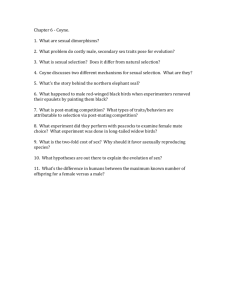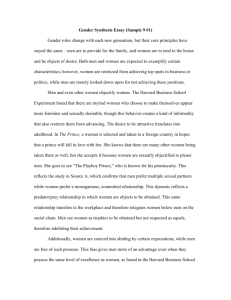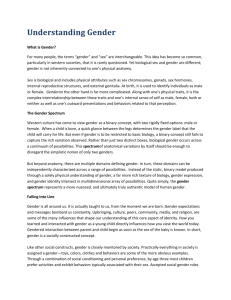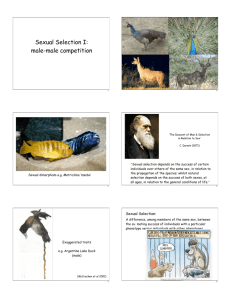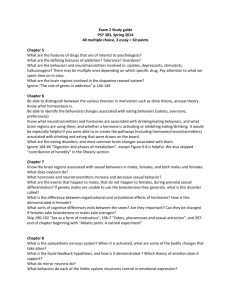Chapter 13e - Darwin's Theory of Sexual Selection
advertisement
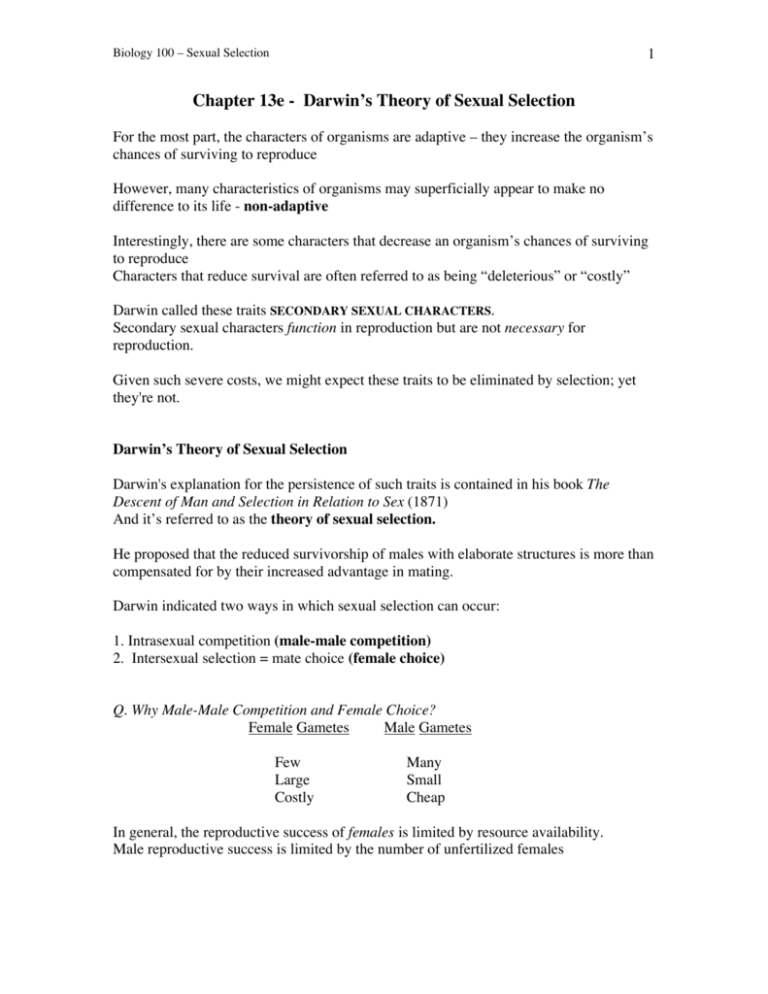
1 Biology 100 – Sexual Selection Chapter 13e - Darwin’s Theory of Sexual Selection For the most part, the characters of organisms are adaptive – they increase the organism’s chances of surviving to reproduce However, many characteristics of organisms may superficially appear to make no difference to its life - non-adaptive Interestingly, there are some characters that decrease an organism’s chances of surviving to reproduce Characters that reduce survival are often referred to as being “deleterious” or “costly” Darwin called these traits SECONDARY SEXUAL CHARACTERS. Secondary sexual characters function in reproduction but are not necessary for reproduction. Given such severe costs, we might expect these traits to be eliminated by selection; yet they're not. Darwin’s Theory of Sexual Selection Darwin's explanation for the persistence of such traits is contained in his book The Descent of Man and Selection in Relation to Sex (1871) And it’s referred to as the theory of sexual selection. He proposed that the reduced survivorship of males with elaborate structures is more than compensated for by their increased advantage in mating. Darwin indicated two ways in which sexual selection can occur: 1. Intrasexual competition (male-male competition) 2. Intersexual selection = mate choice (female choice) Q. Why Male-Male Competition and Female Choice? Female Gametes Male Gametes Few Large Costly Many Small Cheap In general, the reproductive success of females is limited by resource availability. Male reproductive success is limited by the number of unfertilized females Biology 100 – Sexual Selection If sexual selection works primarily on males, we would expect to see more variation in male mating success than in female mating success. This was tested in 1948 by A. J. Bateman with Drosophila He observed experimental populations and counted the number of mating by males and females. There was little variation in female mating success. Few females failed to mate, most mated once or twice, a few mated 3 times. In contrast, many males failed to mate, while some males obtained 3 or more matings. Male fruitflies thus show greater variation in mating success than do females. Evolution of Traits due to Male-Male Competition Males may monopolize females one of two ways: 1. Direct competition involves fighting over resources necessary to attract females, or directly over females themselves. - Territories - Females - Mate guarding 2. Indirect competition involves competition that doesn't include fighting between males. - Sperm plugs - Sperm competition Female Choice Many secondary sexual characters appear to play no role in male-male competition Darwin suggested that the elaborate tails of male peacocks exist because females preferred to mate with males that had longer, brighter, or more beautiful tail If this is true, then the mating advantage of males with longer tails will compensate for the corresponding amount of reduced male survival Note: 1. Darwin’s main argument for the importance of sexual selection was comparative 2. Biologists had a hard time accepting that female animals have some aesthetic sense that makes them choose some males over others. 2 Biology 100 – Sexual Selection 3 Evidence of female choice: MØller work with barn swallows Upon arriving to breeding colonies in the spring, males establish a small territory and then tries to attract a mate by displaying his tail while perching and flying Each female visits several males and then chooses one to pair with There is a tremendous amount of sexual dimorphism among males and females and Moller hypothesized that sexual selection through female choice was operating Moller captured and banded 44 males that established territories, but that had not yet mated He divided them into 4 groups of 11: 1. 2. 3. 4. Shortened tail feathers Mock-altered (control 1) Unaltered (control 2) Elongated tail feathers Birds were released back into the colony He predicted that if females prefer males with longer tail feathers, then the males with elongated tails would a) attract mates sooner, and fledge more young, then either control 1 males or control 2 males The control males should, in turn, be more successful than the shortened males Two Major theories have been used explain the evolution of sexually selected traits! 1. Runaway selection (R.A. Fisher, 1958).! Definition of runaway selection: an initially naturally selected trait in males accompanies preference for that trait in females.! Thus, all elaborate traits once had a naturally selected component, no matter how small.! The trait may become further elaborated for reasons of sexual selection alone. 2. The Handicap principle (Zahavi 1975). Zahavi’s model predicts that sexually selected traits are elaborate because they tend to lower the survivorship of the individual having them, not merely as a by-product of mate choice.! Thus, a female who is discriminating between males with and without a sexually selected character, is in effect discriminating between males who have and have not passed a test.! The more elaborate the character, the more severe the test, and the better the male must be to have survived such a handicap.! Biology 100 – Sexual Selection 4 Honest advertisement models But many traits that are preferred by females will not put males at greater risk. Thus, the term “handicap” is sometimes misleading, as characters that serve as indicators of male quality may not impose a direct viability cost to those males. Zahavi’s Handicap principle is now considered a subset of the “honest advertisement model” Q. What gets honestly advertised? - Good genes model. - Good resources (aka good parent) model.! - Good current condition.! The Parasitic Theory of Sexual Selection Hamilton’s 1979 parasite theory of secondary sex characters is a refinement of the “good current condition”model of honest advertisement. It suggests that female choice of healthy males is a special case of female choice for good genes 1. A comparative look at the parasite theory of sexual selection - Hamilton and Zuk (1982) Hamilton and Zuk reasoned that some bird species will suffer from parasites more than other This parasitism will then set up selection on females to choose resistant mates, and the selection will be stronger in species suffering from high parasite loads than in species suffering lower loads If male secondary sex characters do enable females to choose resistant males, we should expect to find the relatively brightly colored males in the more strongly parasitized species Collected data on the parasite loads and relative coloration of males and females from 109 bird species And they found a relation between the two variables - bird species that suffer more from parasites do have brighter male coloration Biology 100 – Sexual Selection 5 2. An experimental look at the parasite theory of sexual selection - Moller experiments using barn swallows (1994) Moller measured the health of male swallows by counting the numbers of a bloodsucking mite on the bird’s heads And he found that males with longer tails had fewer parasitic mites Q. But, is the male’s health (resistance) passed on to his offspring? To test this, Moller placed 50 mites in the nests of swallows with all tail lengths, and counted the number of mites on the offspring in each nest at a later time He found that offspring with longer tailed fathers carried fewer mites He was also able to confirm that the effect was genetic Moller cross-fostered baby swallows, by moving them between nests immediately after hatching (swallows treat foster offspring like their own) There was no relationship between the parasite load of the young swallows moved to another nest and the tail length of the foster father at their nest Sexual Selection and the Mating Mind The human mind evolved somehow. Yet it remains unclear what selection pressures favored our large brains, our creative intelligence, and our unique capacities for language, art, music, humor, romantic love, and moral commitment. Following Herbert Spencer's misleading phrase 'the survival of the fittest', most theorists throughout the last 140 years have tried and failed to identify the 'survival value' of these capacities. One idea that has become influential in the last few years is known as the Machiavellian hypothesis, which has its origins in the work of Richard Alexander in the 1970s. He suggested that the main evolutionary pressure for human beings to increase in intelligence was competition with other people, in particular, sexual competition between individuals of the same sex. Biology 100 – Sexual Selection 6 Matt Ridley and Geoffrey Miller suggest that runaway sexual selection as described by Fisher is sufficient to explain the huge increase in brain size. Being intelligent, witty and entertaining was sexy to our ancestors! This hypothesis requires only that there was an initial preference for more intelligent mates that drove the process from then on. This helps to explain why only humans developed in this way. First, because the initial preference was quite arbitrary and only came about by chance and we can thus assume that an equivalent preference never arose in the other apes. Second, because the human mating system is unique among apes in that it is characterized primarily by monogamous pair bonding (with occasional polygamy) and shared parental effort in child rearing. There is a least one caveat: The lack of sex differences in human mental capacities becomes a strong argument against the runaway brain theory. Thus, Fisher’s model is too simple to explain a situation in which both sexes are choosy, and both display their mental traits during courtship. Recent Ideas about Sexual Selection and the Human Mind Many of the traits we're selecting when we choose a mate are not just arbitrary traits, They are actually powerful indicators of things that matter in reproduction: - a lot of beauty is really an indicator of health and fertility - a lot of traits that are psychologically attractive to us, like kindness, warmth, creativity, intelligence, imagination, are indicators of somebody's ability to get along in the world People appear to choose their mates, not just for physical appearance, but for a series rich psychological traits David Buss’ study of sexual preferences in 37 cultures all around the world found that in every culture, the top two most desired traits in a mate, for both sexes, were kindness and intelligence. It is fascinating that two of the major traits that distinguish us from other primates are the same traits that we search for in mates—that are currently under the strongest sexual selection. Biology 100 – Sexual Selection Mating Mind Hypothesis If sexual selection drove human mental evolution, it must have been a form of sexual selection that could work given mutual mate choice. The human mind may have evolved through some combination of: - runaway sexual selection - sexual selection for fitness indicators - psychological biases favoring certain details of ornament design 7
